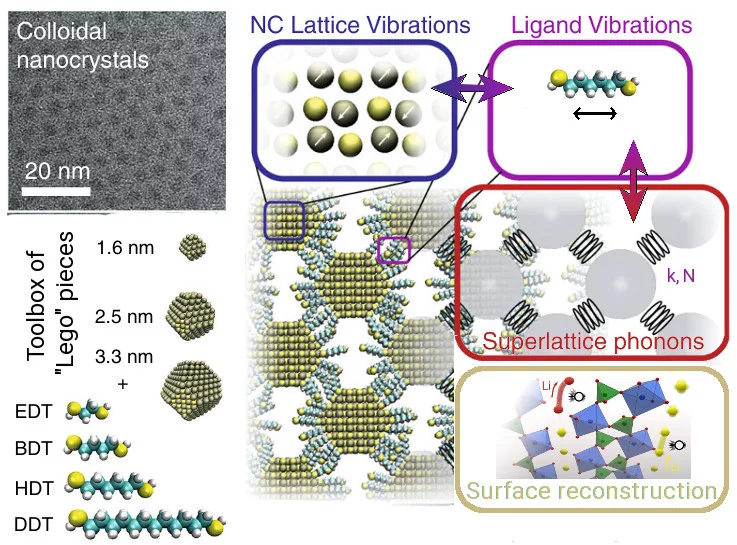Colloidal Nanocrystals are highly tunable systems, which makes them very attractive for cutting edge materials science and engineering. Particle size, shape and ligands are the most common parameters to adjust. Inherently, surfaces play a deterministic role for the applications. A big advantage of this class of nanomaterials lies not only in their assembly, but also in the additional degree of freedom to design their surfaces separately through the adjustment of the ligands.
Neutron scattering can uniquely contribute to the understanding of static and dynamical properties of this type of materials and pave the way for future developments. The combination of neutron- and μ+SR spectroscopy, computer simulations and laboratory methods allows us to identify system relevant processes. We could show for example that in the battery cathode LiFePO4, structural reorganisation and altered phonon modes have an influence on Li+ and charge transport. Ongoing work addresses the dynamics of ligands, which act as elastic medium between the nanocrystals, and can be characterized by an effective spring constant. We could even measure superlattice phonons, which are more interesting from basic science point of view.
Publications
- Deniz Bozyigit, Nuri Yazdani, Maksym Yarema, Olesya Yarema, Weyde Matteo Mario Lin, Sebastian Volk, Kantawong Vuttivorakulchai, Mathieu Luisier, Fanni Juranyi & Vanessa Wood: "Soft surfaces of nanomaterials enable strong phonon interactions", Nature 531 (2016) 618–622
- Nuri Yazdani, Maximilian Jansen, Deniz Bozyigit, Weyde M.M. Lin, Sebastian Volk, Olesya Yarema, Maksym Yarema, Fanni Juranyi, Sebastian D. Huber and Vanessa Wood: "Nanocrystal superlattices as phonon-engineered solids and acoustic metamaterials", Nature Comm. 10 (2019) 4236
- Peter Benedek, Nuri Yazdani, Hungru Chen, Nils Wenzler,Fanni Juranyi, Martin Månsson, M. Saiful Islam and Vanessa C. Wood: "Surface phonons of lithium ion battery active materials", Sustainable Energy Fuels 3 (2019) 508
- P. Benedek, O.K. Forslund, E. Nocerino, N. Yazdani, N. Matsubara, Y. Sassa, F. Juranyi, M. Medarde, M. Telling, M. Mansson, V. Wood: "Quantifying Diffusion through Interfaces of Lithium-Ion Battery Active Materials", Applied Materials and Interfaces 12/14 (2020) 16243-16249
Collaboration
- Prof. Dr. Vanessa Wood, ETHZ
- Prof. Dr. Martin Månsson, KTH Stockholm
Associated junior researchers
- Maximilian Jansen. ETHZ
- Ola Kenji Forslund, KTH Stockholm
